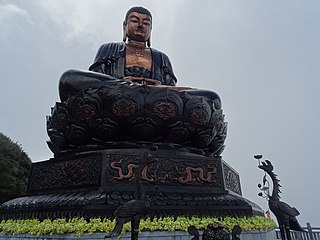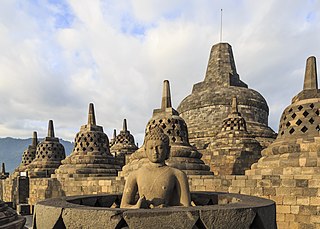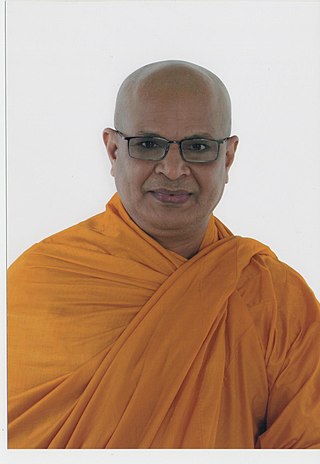Theravāda is the most commonly accepted name of the oldest existing southernmost branch of the Buddhist religion. The school's adherents, termed Theravādins, have preserved their version of Gautama Buddha's teaching or dhamma in the Pāli Canon for over two millennia.

The World Fellowship of Buddhists (WFB) is an international Buddhist organization. Initiated by Gunapala Piyasena Malalasekera, it was founded in 1950 in Colombo, Ceylon, by representatives from 27 nations. Although Theravada Buddhists are prominent in the organization,, members of all Buddhist schools are active in the WFB. It has regional centers in more than 30 countries, including India, the United States, Australia, and several nations of Africa and Europe, in addition to traditional Buddhist countries.

Balangoda Ananda Maitreya Thero was a Sri Lankan Buddhist monk who was one of the most distinguished scholars and expositors of Theravada Buddhism in the twentieth century. He was highly respected by Sri Lankan Buddhists, who believed that he had achieved a higher level of spiritual development. Sri Lankan Buddhists also considered Balangoda Ananda Maitreya Thero as a Bodhisattva, who will attain Buddhahood in a future life.

Theravada Buddhism is the largest state religion headquartered in Sri Lanka, practiced by 70.2% of the population as of 2012. Practitioners of Sri Lankan Buddhism can be found amongst the majority Sinhalese population as well as among the minority ethnic groups. Sri Lankan Buddhists share many similarities with some Southeast Asian Buddhists, specifically Myanmar Buddhists and Thai Buddhists due to traditional and cultural exchange. Sri Lanka is one of only five polities in the world where Theravada Buddhism is the predominant religion, and others are Thailand, Cambodia, Laos and Myanmar.

Buddhism is the largest religion in Singapore, practiced by approximately 31.1% of the population as of 2020. As per the census, out of 3,459,093 Singaporeans polled, 1,074,159 of them identified themselves as Buddhists.
Walpola Rahula Thero was a Sri Lankan Buddhist monk, scholar and writer. In 1964, he became the Professor of History and Religions at Northwestern University, thus becoming the first bhikkhu to hold a professorial chair in the Western world. He also once held the position of Vice-Chancellor at the then Vidyodaya University. He has written extensively about Buddhism in English, French and Sinhala. He wrote the book What the Buddha Taught about Theravada Buddhism.

Buddhism in Vietnam, as practiced by the Vietnamese people, is a form of East Asian Mahayana Buddhism. It is the main religion in Vietnam. Vietnamese Buddhism is generally inclusive and syncretic, drawing on the main Chinese Buddhist traditions, such as Tiantai and Huayan, Zen (Thiền), and Pure Land.

Buddhism in Thailand is largely of the Theravada school, which is followed by roughly 93.4 percent of the population. Thailand has the second largest Buddhist population in the world, after China, with approximately 64 million Buddhists. Buddhism in Thailand has also become integrated with folk religion (Bon), Hinduism from millennia of Indian influence, and Chinese religions from the large Thai Chinese population. Buddhist temples in Thailand are characterized by tall golden stupas, and the Buddhist architecture of Thailand is similar to that in other Southeast Asian countries, particularly Cambodia and Laos, with which Thailand shares cultural and historical heritages. Thai Buddhism also shares many similarities with Sri Lankan Buddhism. Thailand, Cambodia, Myanmar, Sri Lanka and Laos are countries with Theravada Buddhist majorities.
The Basic Points Unifying the Theravāda and the Mahāyāna is an important Buddhist ecumenical statement created in 1967 during the First Congress of the World Buddhist Sangha Council (WBSC), where its founder Secretary-General, the late Venerable Pandita Pimbure Sorata Thera, requested the Ven. Walpola Rahula to present a concise formula for the unification of all the different Buddhist traditions. This text was then unanimously approved by the council.

Buddhism in Southeast Asia includes a variety of traditions of Buddhism including two main traditions: Mahāyāna Buddhism and Theravāda Buddhism. Historically, Mahāyāna had a prominent position in the region, but in modern times, most countries follow the Theravāda tradition. Southeast Asian countries with a Theravāda Buddhist majority are Thailand, Cambodia, Laos, Myanmar, all of them mainland countries.

Abhayagiri Vihāra was a major monastery site of Theravada, Mahayana and Vajrayana Buddhism that was situated in Anuradhapura, Sri Lanka. It is one of the most extensive ruins in the world and one of the most sacred Buddhist pilgrimage cities in the nation. Historically it was a great monastic center as well as a royal capital, with magnificent monasteries rising to many stories, roofed with gilt bronze or tiles of burnt clay glazed in brilliant colours. To the north of the city, encircled by great walls and containing elaborate bathing ponds, carved balustrades and moonstones, stood "Abhayagiri", one of seventeen such religious units in Anuradhapura and the largest of its five major viharas. One of the focal points of the complex is an ancient stupa, the Abhayagiri Dagaba. Surrounding the humped dagaba, Abhayagiri Vihara was a seat of the Northern Monastery, or Uttara Vihara and the original custodian of the Tooth relic in the island.

Buddhism is a major religion in Hong Kong and has been greatly influential in the traditional culture of its populace. Among the most prominent Buddhist temples in the city there are the Chi Lin Nunnery in Diamond Hill, built in the Tang dynasty's architectural style; the Po Lin Monastery on Lantau Island, famous for the outdoor bronze statue, Tian Tan Buddha, which attracts a large number of visitors during the weekends and holidays.

Ven. Thich Nhat Tu or Thích Nhật Từ (釋日慈) in Vietnamese is a Vietnamese Buddhist reformer, an author, a poet, a psychological consultant, and an active social activist in Vietnam. He is committed to propagate Buddha's teachings through education, cultural activities and charitable programs in order to benefit the individuals and the society at large.
The World Buddhist Scout Council (WSBC) formerly the World Buddhist Scout Brotherhood until 2009 is an autonomous, international body committed to promoting and supporting Buddhism within Scouting. The WBSB began as a means to facilitate religious activities among Buddhist Scouts. The WBSC was declared active with the election of its chairman on July 21, 2004, and received consultative status with the World Scout Committee at the WSC meeting on March 9, 2009. The World Scout Committee's guidelines indicate that at least three years is required to fulfill the requirements before consultative status may be granted.
Vạn Hạnh Monastery is a Zen Buddhist temple in Ho Chi Minh City, the largest city in Vietnam. The temple is located at 716 Nguyễn Kiệm Street on the road between Go Vap and Phu Nhuan districts. It is the location of the main Buddhist training centre for sangha in Vietnam, and is also the office of the Vietnamese Buddhist Research Institute.

The Vietnam Buddhist Sangha is the only Buddhist sangha recognised by the Vietnamese government, and a member of the Vietnamese Fatherland Front. It was founded after Vietnam's Buddhist Convention at Quán Sứ Pagoda on November 7, 1981, to unify Buddhist activities of Vietnamese monks, nuns and lay followers.

Ven Bogoda Seelawimala Nayaka Thera is the incumbent Head Priest of the London Buddhist Vihara and the current Chief Sangha Nayaka of Great Britain. He was appointed Chief Bhikkhu of the London Buddhist Vihara on 8 May 2008 following the demise of Ven Dr Medagama Vajiragnana Nayaka Thera. Ven Seelawimala Nayaka Thera hails from the Malwatte Chapter of the Siam Nikaya in Sri Lanka.

A bhikkhunī or bhikṣuṇī is a Buddhist nun, fully ordained female in Buddhist monasticism. Bhikkhunīs live by the Vinaya, a set of either 311 Theravada, 348 Dharmaguptaka, or 364 Mulasarvastivada school rules. Until recently, the lineages of female monastics only remained in Mahayana Buddhism and thus were prevalent in countries such as China, Korea, Taiwan, Japan, and Vietnam, while a few women have taken the full monastic vows in the Theravada and Vajrayana schools. The official lineage of Tibetan Buddhist bhikkhunīs recommenced on 23 June 2022 in Bhutan when 144 nuns, most of them Butanese, were fully ordained.

Bodagama Chandima Thero is a Buddhist monk. As of 2015 he taught Theravada Buddhism in Taiwan. With a group of Taiwanese Buddhists, he founded the Theravada Samadhi Education Association in Taipei.
The history of Theravāda Buddhism begins in ancient India, where it was one of the early Buddhist schools which arose after the first schism of the Buddhist monastic community. After establishing itself in the Sri Lankan Anuradhapura Kingdom, Theravāda spread throughout mainland Southeast Asia through the efforts of missionary monks and Southeast Asian kings.













